2.20 Is Ripple "it" When it Comes to Cross-Border Transactions?
Free Airdrop Season 7 is LIVE! Answer fun questions or do simple tasks to earn rewards from the $30K BitDegree prize pool. Participate Now ! 🔥
In this section, we’re going to talk about what is Ripple & XRP, and what’s the difference between the two!
Ripple is a name that has been causing ripples in the industry for a long time. It’s a company that’s behind not only one of the most popular cryptocurrencies on the market, but also one that’s facing the regulatory authorities in the most intense manner, to date. You could even say that the future of crypto, in some ways, relies heavily on Ripple.
To understand what’s at stake, it’s important to take a deep dive into what does Ripple offer to the crypto community, how does their project stand out, and, most importantly, how and why do people at Ripple refuse to agree with the US regulatory authorities about how cryptocurrencies are viewed.
o, in this section, we’re going to answer such questions as “What is Ripple XRP?”, “What is XRP used for?”, and what conclusions can you draw if you take a look at it from the “XRP vs Bitcoin” perspective. It’s a household name, and you cannot understand the contemporary crypto landscape without understanding the situation surrounding Ripple and XRP.
Let’s see what it is all about!

Video Explainer
Video Explainer: Is Ripple "it" When it Comes to Cross-Border Transactions?
Reading is not your thing? Watch the "Is Ripple "it" When it Comes to Cross-Border Transactions?" video explainer
What is Ripple? Beginner-Friendly XRP Explainer (Animated)


What is Ripple?
To put it very simply, the answer to “What is Ripple crypto?” would sound something like this: a blockchain-based technology and cryptocurrency company with a focus on revolutionizing cross-border payments. These “cross-border payments” are exactly what they sound like - money transfers that take place between the parties from different countries, and that are settled with the help of blockchain technology.
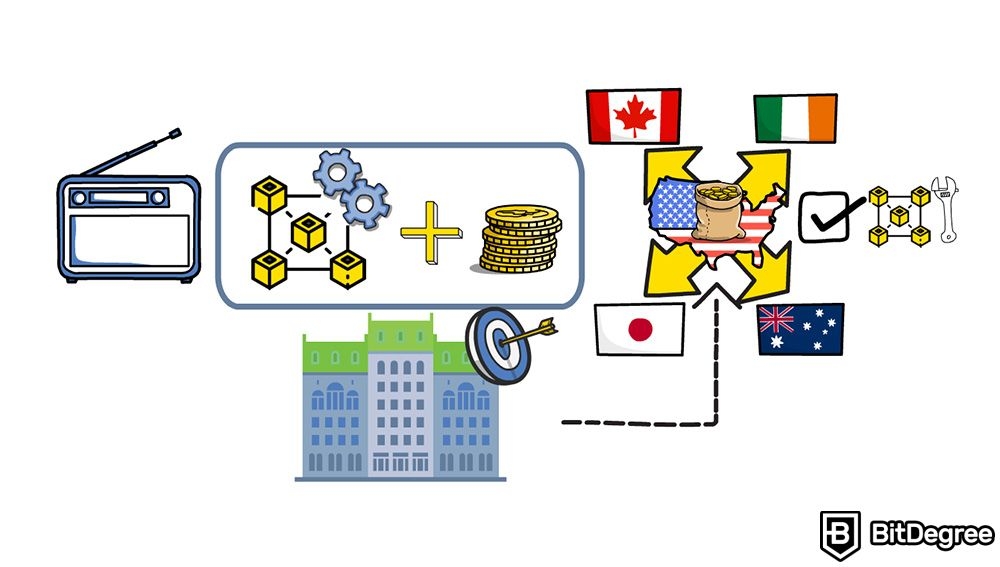
So, Ripple offers solutions to financial institutions to enable faster, more cost-effective and transparent international transactions. Now, to get a full picture, it’s important to address the question, “What is XRP crypto?” XRP is Ripple's native cryptocurrency, and it serves as a bridge currency to facilitate these transactions.
But that’s only the surface-level answer to these questions. In order to fully get the picture of what is XRP crypto, and what role it plays in the whole crypto ecosystem, we have to zoom out and take a look at the entire Ripple timeline, what challenges has this company faced, and what milestones has it achieved.
Ripple, a Timeline
So, Ripple’s story began in 2004 when Ryan Fugger created RipplePay, an early iteration that laid the groundwork for what would later become the Ripple we know today. Fugger's concept aimed to establish a decentralized digital currency system, sparking the initial inspiration for the project.
Fast forward to 2011, and RipplePay caught the attention of Jed McCaleb, a programmer and entrepreneur with a vision to create a digital currency solution that seamlessly integrates with traditional finance. In 2012, McCaleb joined forces with Chris Larsen, a fintech veteran, to co-found OpenCoin.
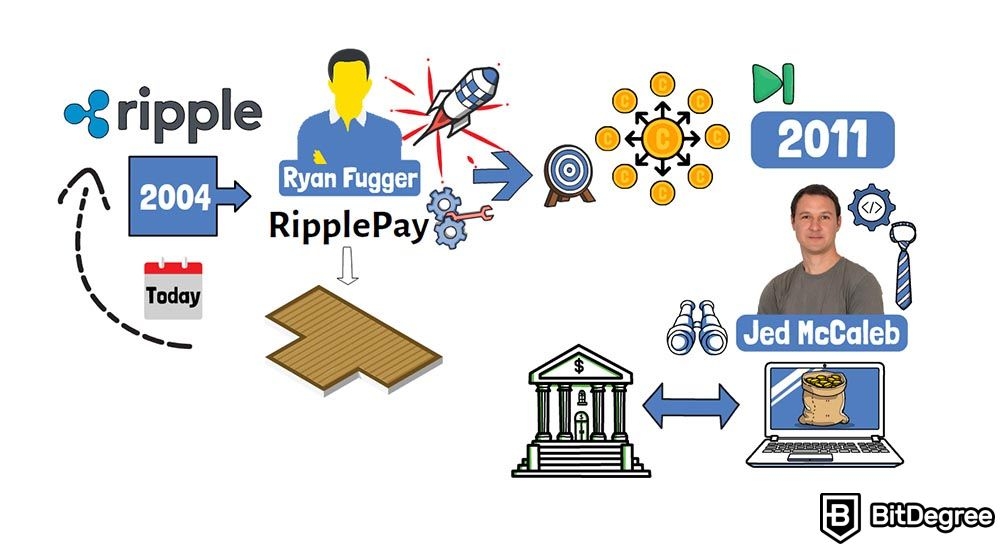
Chris Larsen and Jed McCaleb recognized that the global financial system was ripe for disruption, and that blockchain technology held the potential to revolutionize the way value was transferred and financial transactions were conducted.
Fueled by this conviction, they embarked on a journey to create a solution that would bridge the gap between the existing financial infrastructure and the emerging possibilities of blockchain tech.
Their mission was to develop a digital payment protocol that could redefine the way money moves globally. OpenCoin's evolution led to the introduction of the Ripple protocol, which aimed to streamline cross-border transactions using blockchain technology. With the protocol came the birth of XRP, Ripple's native cryptocurrency, designed to facilitate fast and cost-effective international money transfers.
We’re going to get into specifics of XRP and the way Ripple functions in a minute. But before doing so, let’s finish the overview of Ripple's journey.
So, the years that followed saw the company expressing a strategic focus on forming partnerships with traditional financial institutions. In 2014, Ripple began collaborating with industry giants like American Express or Standard Chartered, aiming to leverage its technology for more efficient global transactions. As these partnerships took shape, Ripple's role in the financial landscape began to solidify.
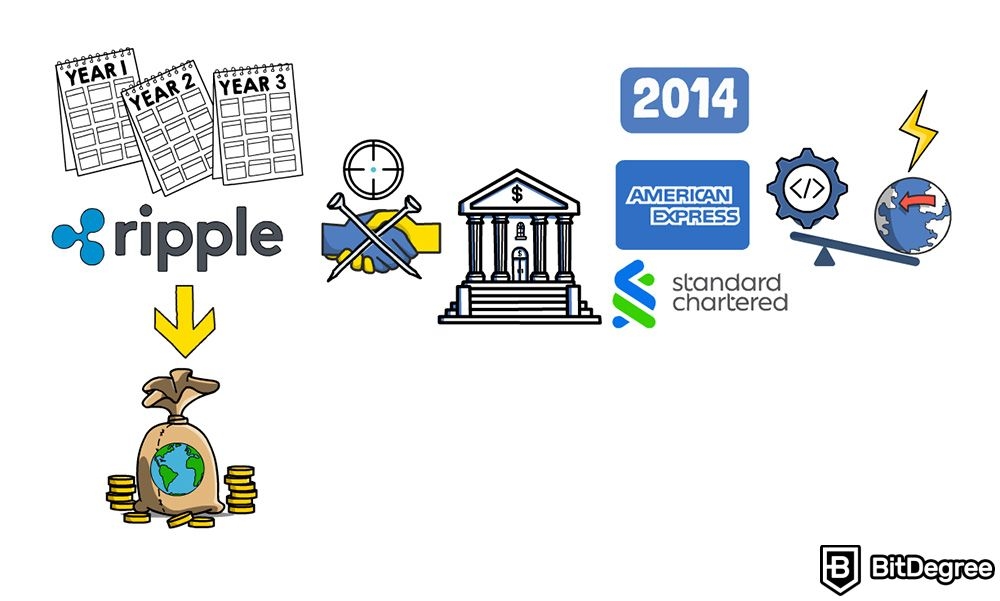
However, Ripple's journey was not without its hurdles. Regulatory uncertainties surrounding the classification of cryptocurrencies posed quite a challenge. In 2018, debates emerged about whether XRP could be classified as a security or utility token.
The debate intensified as the cryptocurrency market experienced rapid growth and volatility. Amid these challenges, Ripple introduced the Interledger Protocol (ILP), a groundbreaking initiative to facilitate seamless transactions across various payment networks.
The legal landscape became even more complex in 2020 when the U.S. Securities and Exchange Commission (SEC) filed a lawsuit against Ripple. The lawsuit alleged that the sale of XRP constituted an unregistered securities offering. Ripple responded by firmly asserting its position that XRP is not a security and defending its actions.
This legal battle raised pivotal questions about the regulatory classification of cryptocurrencies and their implications for the industry.
We’re going to get into the specifics of the infamous SEC vs Ripple case at the end of this section, because this isn’t just a simple legal question. It’s a battle that may redefine the future of crypto.
How Does Ripple Work?
Now, as I’ve already mentioned, one of the key challenges that Ripple sought to overcome was the sluggishness of cross-border transactions. Traditional methods of sending money across borders were characterized by lengthy processing times, intermediaries, and high costs. This created a significant barrier to businesses and individuals alike, making things run slower than they could.
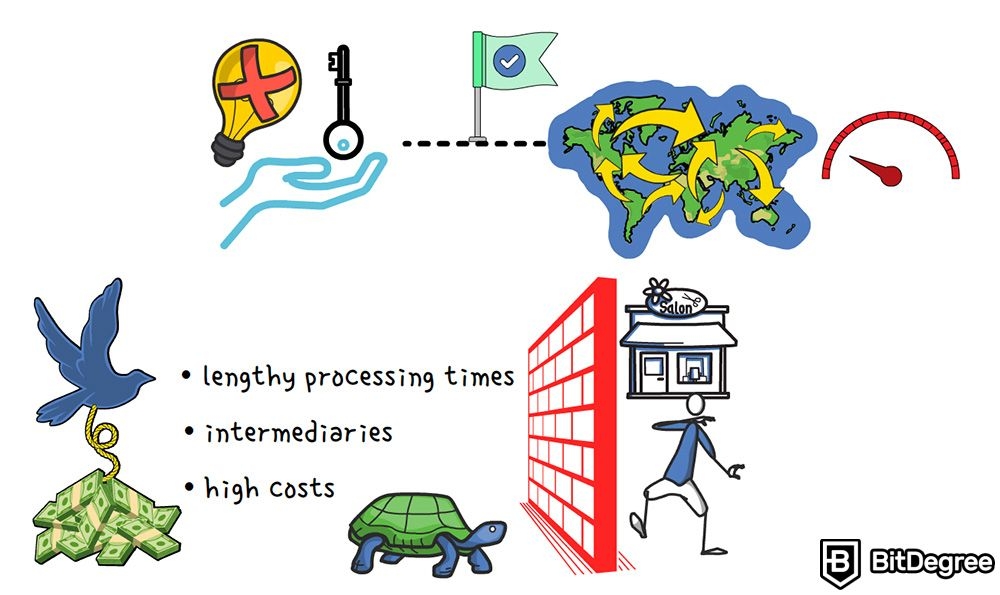
Ripple's solution to this challenge came in the form of its innovative payment protocol and digital currency, XRP. Ripple introduced a network that enabled real-time, cross-border transactions with reduced costs and enhanced efficiency. XRP played a pivotal role in facilitating these transactions by serving as a bridge currency that could be easily converted to various fiat currencies.
But to continue answering the question of “What is Ripple cryptocurrency?”, let's delve into how Ripple works and unveil the mechanics behind their products.
At the core of Ripple's operation lies the Ripple Protocol, which serves as the technological foundation. This protocol employs a unique consensus mechanism that sets it apart from other blockchain networks. Instead of energy-intensive mining, Ripple employs a consensus algorithm known as the Ripple Protocol Consensus Algorithm (RPCA).
This mechanism enables the network to reach consensus without relying on Proof-of-Work (PoW) or Proof-of-Stake (PoS) methods, making it faster and more energy-efficient.
The second ingredient that’s partially accountable for Ripple’s success is Ripple's distributed ledger, also known as the XRP Ledger. This ledger doesn't just store transactions - it records a wide range of data, including offers to buy or sell assets and even smart contracts.
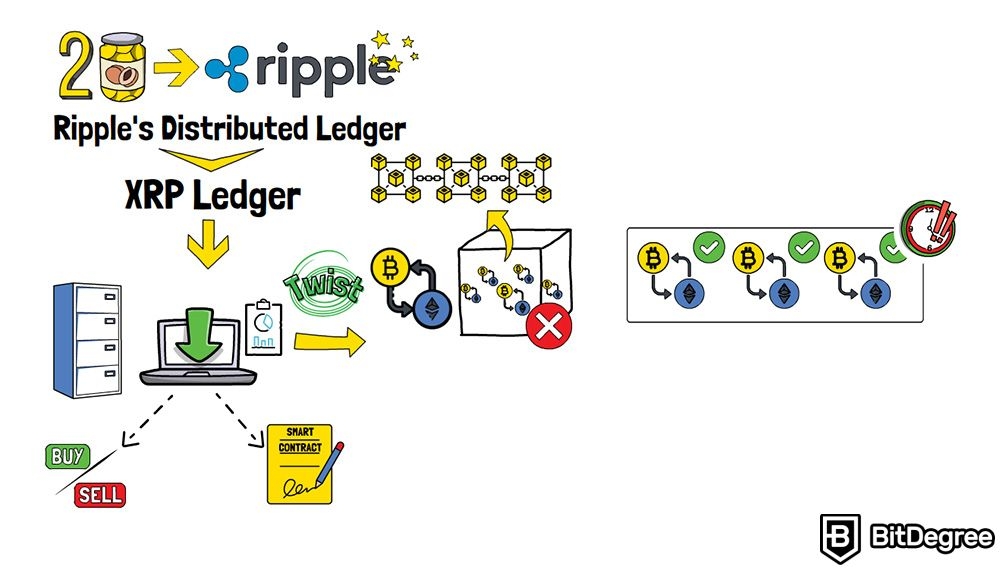
But here's the twist: transactions on the XRP Ledger aren't grouped into blocks like traditional blockchains. Instead, they're individually validated as they occur, resulting in near-instant transaction confirmation.
That being said, we also have to talk about RippleNet. Imagine a digital highway connecting financial institutions across the globe. That's RippleNet. It's a network of banks, payment providers, and other financial institutions that facilitates seamless cross-border transactions.
RippleNet's suite of tools, including xCurrent and On-Demand Liquidity (ODL), empowers participants to send money across borders with speed and transparency that traditional systems could only dream of.
All of these features fit under the category of Liquidity Solutions because that’s essentially what Ripple aimed to improve. To rephrase it in a simple way, think of liquidity as the speed at which you can turn stuff into cash. It's like having a vending machine for your assets – the easier and faster you can get your hands on the cold, hard cash, the more liquid your assets are. So, apply this definition to cross-border payments, and you have liquidity solutions that work.
Picture this: financial institutions need liquidity in foreign markets to process transactions. Traditionally, this required pre-funded accounts in each country, tying up capital. But the already-mentioned On-Demand Liquidity flips the script.
It leverages XRP to provide instant liquidity on demand. Financial institutions can convert one currency into XRP, send it across borders in a flash, and then convert it back into the local currency on the other end. Voilà, instant and affordable liquidity without the hassle that was taken for granted before introducing these novelties.
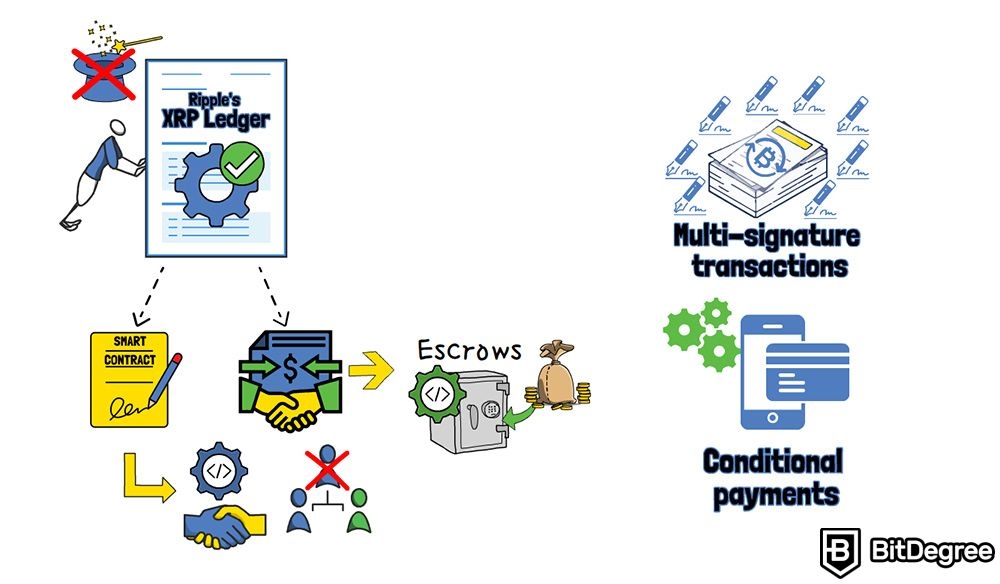
At this point, the question of “What is XRP cryptocurrency?” must be addressed. XRP is the digital glue that holds Ripple's vision together. It serves as a bridge asset, offering a means of transferring value between different currencies. Whether it's converting from dollars to euros or yen to pesos, XRP acts as the intermediary, enabling cost-effective and efficient cross-border transactions.
But Ripple's XRP Ledger isn't just a one-trick tool. It supports smart contracts and escrows too. Smart contracts enable automated, self-executing agreements without intermediaries, revolutionizing business processes. Escrows, on the other hand, provide a secure way to hold funds until predefined conditions are met. Whether it's complex multi-signature transactions or conditional payments, the XRP Ledger has it covered.
Now, all of this pretty much sums up what made Ripple kind of a big deal, and answers the question of “What is XRP used for?” Yet, we’re in crypto, which means that we have to take a better look at XRP, since, when it comes to trading, the XRP cryptocurrency is where it’s all at.
XRP Tokenomics
Created back in 2012, when Ripple was known as OpenCoin, XRP's purpose wasn't just to play the role of another cryptocurrency. It's not mined like Bitcoin; instead, all the 100 billion XRP coins were created at once, which means that the concept of mining farms is foreign when it comes to Ripple.
By the way, to understand what these mining farms are all about, check out this section.
Okay, back to answering the question of “What is Ripple XRP?”
XRP had an initial supply of 100 billion tokens. But as of now, the circulating supply is around 46 billion. Why the shrink? Ripple decided to lock up a chunk of those XRP tokens in escrow accounts to ensure a controlled release into the market to keep inflation levels low. Every month, a portion of these escrowed tokens gets released, and any unused ones are sent back to the backroom for safekeeping.
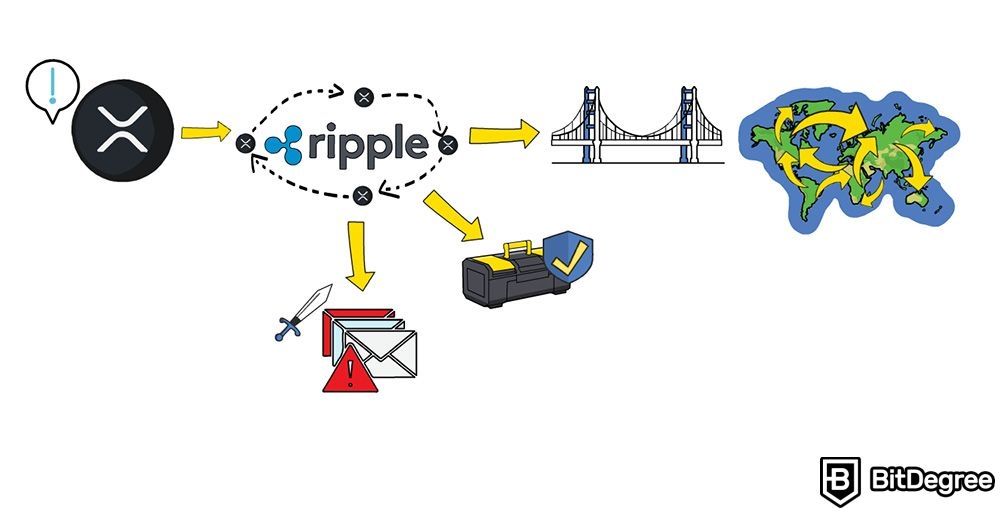
When it comes to XRP’s importance in the Ripple ecosystem, it plays multiple roles: as a bridge currency for cross-border payments, a tool to help secure transactions, and a way to help fight spam.
Now, there's this term called "burning". When transactions happen on the Ripple network, a small amount of XRP gets destroyed. This reduces the total supply of XRP over time, giving it a hint of deflationary nature to the cryptocurrency.
It’s thanks to Ripple’s active involvement in looking for serious, long-term partnerships, that XRP didn’t tank and continued to stay relevant as one of the top cryptos in the market. But like any successful story, XRP has its share of drama. The question of whether XRP is a security or not has sparked legal, seemingly never-ending disputes with regulators.
Ripple vs SEC
When trying to answer the question of “What is Ripple XRP?”, you often end up with the finding that Ripple is at the avant-garde of the crypto industry’s battle with the regulatory authorities about the official, legal status of many cryptocurrencies. Here’s the gist of this landmark case.
The SEC filed a lawsuit in 2020, alleging Ripple's unregistered XRP sales during an initial public offering (IPO) back in 2013 when the company founders were raising funds. The lawsuit accused Ripple’s co-founders of unregistered XRP transactions worth $600 million. The SEC claims that XRP's sale funded Ripple's operations and enriched its management.
The lawsuit challenges whether XRP should be considered a security. Unlike Bitcoin, the SEC believes XRP fits this classification due to its funding of Ripple's platform. The Howey test, a legal precedent, evaluates if an investment contract is a security. The SEC claims XRP satisfies this test's requirements, as investors lack control over XRP's profit.
In the legal battle, Ripple opted to fight rather than settle, arguing the SEC's bias. Ripple questioned the SEC's classification of XRP while exempting Ethereum.
In a landmark ruling, Judge Analisa Torres partially favored Ripple, stating that only the XRP sales to hedge funds and institutional buyers were unregistered securities offerings. However, the case continues, with Ripple possibly appealing the decision or seeking a settlement.
The outcome holds implications for crypto regulations and may shape future regulatory proceedings against crypto firms. Therefore, if things go in Ripple’s favor… the future of crypto is surely going to be interesting. So, it’s safe to say that Ripple’s success is not only something that XRP holders are interested in.
Wrapping Up
No, we have reached the point where it’s time to wrap it up. We have answered such questions as “What is Ripple XRP?”, “What is XRP cryptocurrency?”, “What is XRP used for?”, and ran through the overall story of Ripple, their product and their legal battles with regulatory authorities.
If you want to find out more about other popular crypto projects, make sure to check out other sections in this Crypto 101 Handbook.










